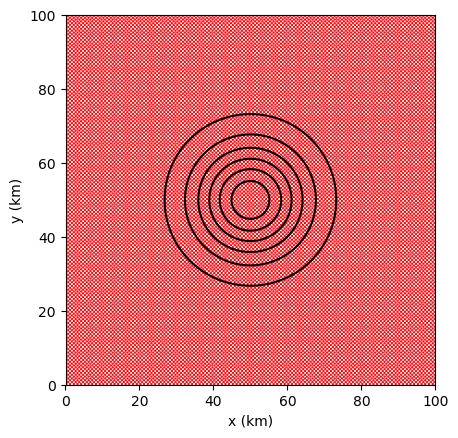Eddy-Internal wave interaction
 We started to look at the interaction between an eddy and a rough
topography. The idea was to understand how internal waves (triggered
by the interaction between current and topography) affect the vertical
structure of an eddy. In this first set of experiments, we set up the
MITgcm
to simulate a barotropic eddy (20km radius) over a sinusoidal
topography ($\lambda = 1$ km).
We started to look at the interaction between an eddy and a rough
topography. The idea was to understand how internal waves (triggered
by the interaction between current and topography) affect the vertical
structure of an eddy. In this first set of experiments, we set up the
MITgcm
to simulate a barotropic eddy (20km radius) over a sinusoidal
topography ($\lambda = 1$ km).
We set the stratification to $N = 10^{-3}$ s$^{-1}$. The eddy is initially in geostrophic balance: the pressure anomaly comes exclusively from a sea surface height anomaly. In cylindrical coordinates centered on the eddy axis of rotation, we have
$$ fu_\theta = -\frac{\partial P}{\partial r}\, , $$
with $u_\theta$ the azimuthal velocity and $r$ the radial coordinate. Here and in the following equations, we assume that the eddy is axisymmetric.
After one day, the velocity profile of the eddy changes dramatically with a strong damping in the lower kilometer (just above the topography), and we were wondering how does this damping occur. The linear equation for the azimuthal velocity is
$$ \frac{\partial u_\theta}{\partial t} = -f u_r + \nu \frac{\partial^2 u_\theta}{\partial z^2} + \frac{\partial }{\partial z} \overline{u'_\theta w} \, ,$$
with the last term $\overline{u'_\theta w}$ the Reynolds stress (where the overline is for the azimuthal average) and we omitted the pressure gradient (because of the axisymmetric constraint). Among the three terms in the rhs of the above equation, the Coriolis term is the main term responsible for the eddy 'damping'. The two other terms are still keys because they are at the origin of the process: in fact, because the Reynolds stress is non zero, it will decrease $u_\theta$ which will disrupt the geostrophic balance and trigger and inward flow (for an anticylone) above the topography. Back in the equation of evolution of $u_\theta$ we see that this inward flow will force $u_\theta$ to grow. Since $u_\theta$ is negative for an anticyclone, it looks like a damping of the eddy but is in fact a gesotrophic adjustment (angular momentum redistribution). In the three figures below, we plotted a vertical cross section of the eddy (azimuthally averaged). In all plots, the contour lines are the azimuthal velocity after one day of the evolution (dashed line: negative velocity for an anticyclone). The first plot is the time derivative of the azimuthal velocity, the second plot is the Reynolds stress term, and the last plot is the coriolis term.


